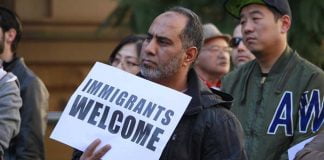There is no doubt that racism has deep roots in Australian society. But where does this racism come from and how can it be pushed back?
There is a widespread myth that racism in Australia is a product of working class prejudice. In the October issue of The Monthly, for example, Robert Manne claims the election result, “confirms the fundamental conservatism of the electorate.”
Racism against Aboriginal people was needed to justify the dispossession and colonisation of Australia from the beginning. But the drive to expand Australian capitalism and exploit the land benefited the early rulers of the colonies, the British military and rich pastoralists, more so than it did early British labourers. Some early convict labourers could see this—and mutinied against their generals, in a few instances taking the side of the subjugated Aboriginals.
This is a pattern that characterises the use of racism throughout Australian history.
The hysteria about boat people can be traced back to the fears about hordes of immigrants from Asia.
Notoriously the White Australia Policy, which banned non-European immigration, was one of the founding pillars of the Australian nation upon Federation in 1901. It was the major way both anti-Chinese and later anti-Japanese racism was entrenched in Australia, and only began to be dismantled under Gough Whitlam in 1973.
Many historians and academics claim its origins can be found as far back as anti-Chinese riots on the goldfields in the 1850s. They argue that restrictions on immigration were introduced to appease white workers, who feared competition for their jobs from Chinese and Asian immigrants.
But the working class was in no position at this time to force the ruling class to adopt such a policy. The Depression of the early 1890s had weakened trade unions. They suffered a series of crushing defeats at the hands of the employers in conflicts such as the maritime and shearers’ strikes.
In Queensland in the 1880s, which was at the forefront of introducing restrictions on Chinese immigration, the union movement barely existed. And there was little connection between anti-Chinese laws introduced at the time of the 1850s gold rushes, which had long been repealed before a new wave of anti-Chinese agitation began in the 1870s that led to White Australia.
Ruling class motives
The ruling class had its own motivations for adopting the White Australia Policy—primarily strategic fears that large scale Asian immigration would create a “fifth column” that would side with China in the case of a war. Asians, particularly Chinese immigrants, were seen as competitors with Europeans in a race to colonise Australia. The colonial ruling class had possession of an entire continent, large parts of which had no permanent European inhabitants, in particular the tropical north closest to Asia. Defence was one of the key motivating factors for the ruling classes of the British colonies spread across Australia to adopt Federation.
There certainly were a series of racist campaigns against Chinese immigration in the years leading up to 1901 involving workers. But the first scare about boat people, directed against Chinese migrants who arrived aboard the SS Afghan in 1888, was whipped up by establishment newspapers and politicians.
The working class certainly bought into these racist campaigns. The Labor Party was a strong supporter of White Australia, and included it in its first Federal Objective in 1905. But this served a purpose for the rulers. While white workers believed that their interests lay with the Australian nation, not with their class, they were much easier to divide and weaken. Many employers knew this.
From the latter decades of the 1800s southern European labourers were used by employers to divide workforces on ethnic lines and break strikes. During a sugar strike in Queensland in 1911, the national general manager of CSR, a giant sugar company, declared that the presence of Italian workers, “were undoubtedly the stumbling block with the unions in preventing them from enforcing their demands on the farmers”.
Australian racism today
The same motivations underscore the use of racism by governments in Australia today.
The rise of One Nation, along with the election of the Howard government in 1996, saw a new wave of racism. Pauline Hanson’s attacks on Aboriginal people, Asians and refugees threatened the creation of a mass racist movement. From the start it was clear her racism provided a way of finding scapegoats for the real problems in Australian society.
The neo-liberal economic policies of the Hawke-Keating government produced a program of privatisations, running down of public services and wage cuts that created a great deal of anger. Hanson condemned globalisation and the job losses in manufacturing due to tariff cuts. But she sought to turn this anger against Aboriginal people and immigrants.
In her maiden speech in parliament Hanson attacked the “privileges Aboriginals enjoy over other Australians”, and blamed immigration for unemployment saying that, “we are in danger of being swamped by Asians”. John Howard’s response was to welcome Hanson’s views by celebrating the fact that people could, “talk about certain things without living in fear of being branded as a bigot or as a racist”.
Howard also fed the climate of racism with a scare campaign against Aboriginal land rights and the limited gains that resulted from the High Court decisions in Mabo and Wik, as well as by refusing to apologise to the Stolen Generations.
He implemented many of Hanson’s policies such as Temporary Protection Visas for refugees and ordered the turning around of refugees on the Tampa in 2001 to win over her supporters. With this went all the rhetoric about refugees being “illegals”, “queue jumpers” and possibly even “terrorists”. This language, and boasts like that by Howard that, “we will decide who comes to this country”, served to conflate refugee and immigration policy—even though the numbers arriving on boats have never been more than 2 or 3 per cent of total annual immigration.
Howard successfully used this racism to remain in power, and ride out opposition to his continuation of the neo-liberal agenda. This allowed him to get away with introducing the GST, running a union busting agenda targeting unions like the MUA and construction unions, passing anti-union laws and pushing through budget cuts. Neo-liberal policies have been a worldwide response to the decline in profit rates since the 1970s, which have resulted in the slow erosion of workers’ living standards in order to boost profits.
Howard’s was a government that consistently ruled for the rich, and needed to sow division in order to get away with it.
Anti-racist tradition
But there has also been a long history of resistance to racism and its destructive effects on the working class. Its success in undermining racism rests on the fact that the working class has a material interest in forging unity across ethnic divisions. If employers have been able to use ethnic divisions to divide workforces and break strikes, or to force down wages for both migrant and local workers, working class unity to resist has been key to a successful fight for wages and conditions.
Often socialists and other radicals in the union movement have been at the forefront of fighting racism.
The efforts of employers to divide workers on the sugar fields of Queensland were overcome in strike action taken to demand action to stop the spread of Weil’s disease in 1934. Radicals in Kalgoorlie campaigned against anti-immigrant violence stirred up by the Returned Soldiers League in 1934, and went on to lead a major strike over working hours the following year, which united all nationalities.
After the new wave of immigration following the Second World War, migrants played a key part in a number of militant union campaigns. One of the more famous examples includes the nine-week strike in 1973 at the Ford Broadmeadows plant, whose 6000-strong workforce was 75 per cent composed of migrant workers. The strike saw unity between a workforce of both local workers and recent migrants from Greece and Turkey whose homelands were bitterly in conflict at the time.
A tradition of anti-racism was also built through campaigns in the 1960s and 1970s for Aboriginal rights, against apartheid in South Africa and against the Vietnam War. Unions provided strong support for Aboriginal workers like the Gurindji strikers. Campaigners against the Vietnam War had to confront the “yellow peril” racism against Asians associated with the White Australia Policy. One of the campaign’s highpoints was the mass Moratorium marches, which were union strike days against the war.
All this points to how to build a successful fight to undermine the racist myths about refugees, the idea population growth is to blame for lack of services, or the racist NT Intervention policies.
The working class—those of us who have no way to support ourselves except through selling our ability to work—remain the overwhelming majority of society. Workers have an interest in fighting racism, and resisting its use by governments to divert attention from attacks on workers’ rights and living standards. And as the history of anti-racist struggles in Australia shows, the working class can be won to an anti-racist position. Activists and socialists today can draw strength from this history in the fight against racism today.
By James Supple





